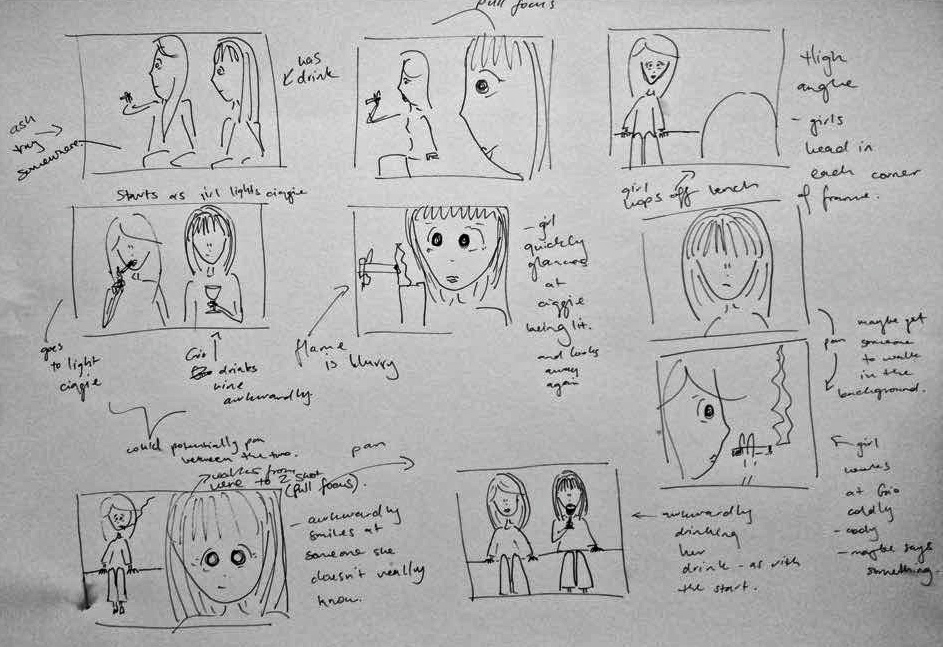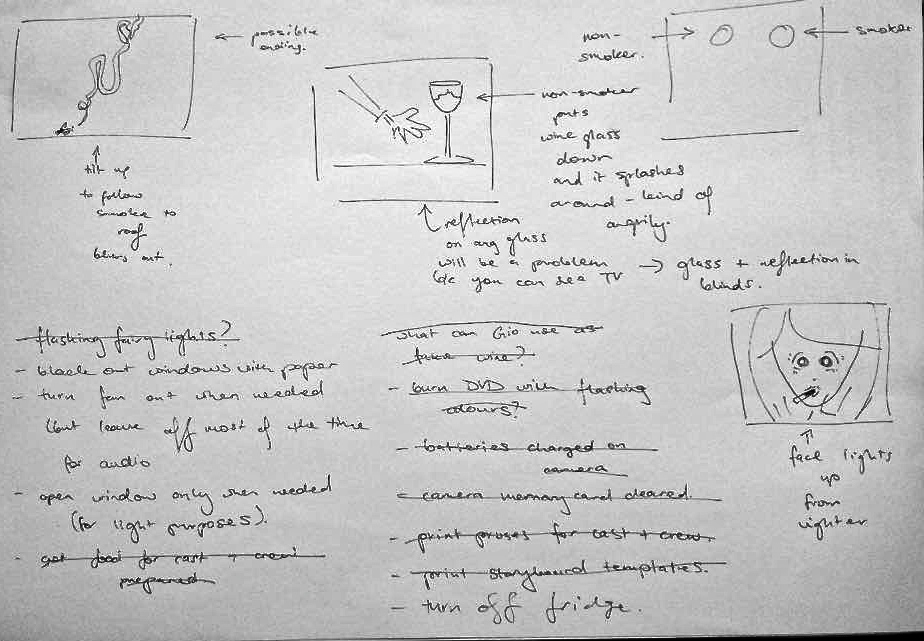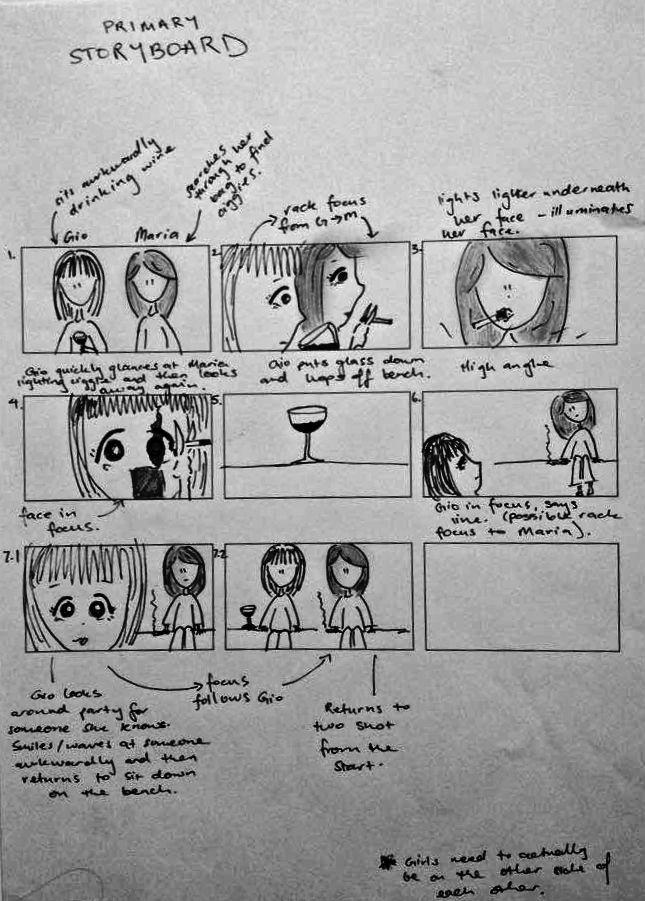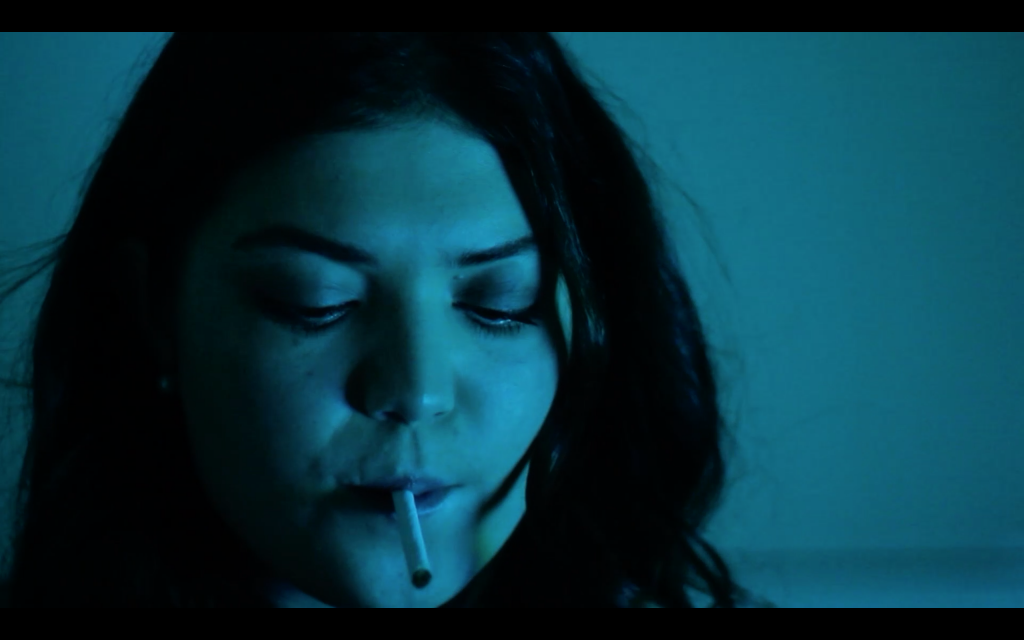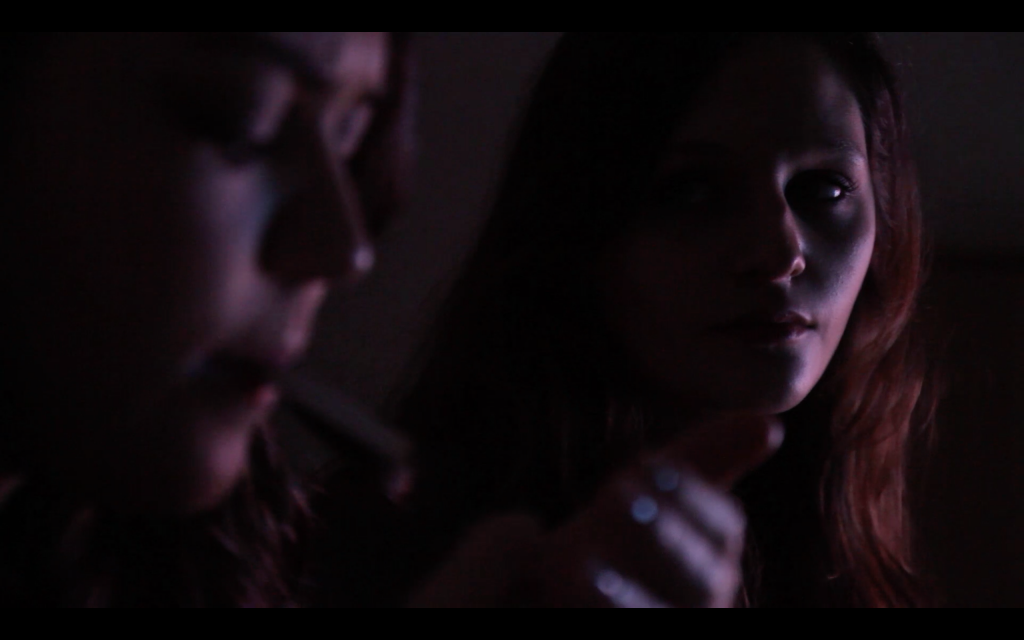This semester has been eye-opening in many more ways than one. I have gained a deeper understanding of the concept of camera coverage, the technical processes associated with filmmaking and the film industry as a whole, but the most important thing I have learnt is how I work best as an individual when it comes to creating a scene.
It was interesting to look back at my initial expectations for the semester, particularly my Week 1 and 2 ‘epiphanies’. After the first filming exercise we did in The Scene in Cinema, I came to the realisation that the ‘traditional, industrial filmmaking methodology’ did not always produce the most ‘considered’ or ‘compelling’ work. This, along with my own research into the shooting methodologies of several directors, led me to investigate various filmmaking processes for my individual assessment. The fact that the course was concentrated on the creation of scenes rather than whole films, meant that I could shoot a scene every week without there needing to be any continuity between the sequences. This worked well for me, because, initially I had planned to use my friends’ scripts as the basis for my scenes, but in the end, I found that many of them didn’t work well cinematically. Fortunately, this course allowed me to experiment with several different scripts (through a kind of trial-and-error process), until I found one that I really wanted to shoot with.
Every week (starting in Week 7) I would conduct a small shooting exercise which explored a selection of diverse filmmaking methods, particularly looking at the way an improvisational approach could help or hinder the final product. Essentially, I was working towards creating an ‘ultimate’ method that would be used to create my final scene for the semester. In order to do this, I researched various directors in regards to how they put their films together and what amount of spontaneity they injected into their pre-production, production and post-production processes. I would then make a scene employing their methodology and reflect on the creation process and the outcome of the work in order to assess which techniques worked best for me. Each director I researched was chosen for a specific reason. I investigated Nicholas Winding Refn because I wanted to see how a very organic approach to shooting would work for me. I chose Woody Allen because he enabled his actors to improvise while on set and he didn’t utilise any storyboards; but, all of his camera coverage and mise-en-scene was pre-prepared. I researched Akira Kurosawa because he used a multi-camera setup for a lot of his shoots (giving him maximum coverage). I thought this meant that the editing process would be the most creative part of making a scene using this method, because the shot types would essentially be determined by the cuts. However, this was not the case. Lastly, I studied Alfred Hitchcock’s method of filmmaking, which was by far the most organised and non-spontaneous practice out of the four. Originally I had planned to keep researching and experimenting with different shooting methods up until the week I was going to shoot my final scene. However, subsequent to making the first four scenes, I decided that it would be more useful to amalgamate the most ‘successful’ processes from the shooting methodologies I had investigated into one ‘ultimate’ method and test this in a shooting exercise instead.
In Week 11 I came up with a list of filmmaking techniques which I thought had worked best for me throughout the semester. Essentially I was bringing together everything I learnt through investigating each director’s different process, as well as methods I had picked up in the first few weeks of the course. For instance, I decided that I wanted to shoot in chronological order, like Nicholas Winding Refn, because I found that this process helped to ‘ensure continuity’ as well as provide ‘a sense of flow to the shoot’ (this is expanded on in my Week 7 Reflection). However, I realised that Winding Refn’s extremely spontaneous approach to filmmaking did not fit me perfectly. When I tested his methodology I felt uncomfortable and rather overwhelmed on set, because I essentially had no idea what I was going to shoot. This is why I decided that I needed to experiment with using a slightly more structured approach to filmmaking. In line with Woody Allen’s shooting method, I found that ‘setting up as much of the equipment as possible before introducing actors onto set’ was a beneficial practice. This would help to lessen the pressure put on me during the shoot, because the actors would not have to wait around until everything was ready. In saying this, I wasn’t completely comfortable with Allen’s methodology either (as expressed in my Week 9 Reflection). He attests to having written all of his films with certain shots and character movements in mind and therefore he does not need to use a storyboard. Because I had not written my own scripts or proses, I ended up documenting all of my ideas for this shoot in picture form; so in a sense I ended up with a storyboard anyway. This is when I realised that storyboarding was seemingly unavoidable for me, hence it became a part of my final methodology.
In terms of Akira Kurosawa’s filmmaking approach, I found that multi-camera setups were not really needed, unless the scene required a lot of physical movement. Although I had thought several cameras shooting at the same time would enable me to have a lot of freedom in post-production, I realised that it was very difficult to elongate or condense time using this technique (I elaborate on this idea in my Week 9 Reflection). Thus, I abandoned the concept, in favour of shooting more coverage with a single camera setup. I noticed that the shoot where I employed Alfred Hitchcock’s methodology was the easiest for me as a director, because every part of the scene had been determined in advance. Despite this aspect, I was least happy with the final edit of this scene. In using Hitchcock’s method I had to essentially ‘edit in camera’, so when I came to cut the scene, there were no ‘back-up’ shots to replace the ones that hadn’t worked out well or didn’t fit in with the rest of the scene.
By the end of all of the shoots I was confused, because there were aspects of each director’s method that I wanted to employ into my own filmmaking, but a lot of these techniques contradicted each other. I was questioning how I was going to have a shoot that ran smoothly, but still had some sense of spontaneity. This is when I came up with the idea of having a prepared storyboard as well as some improvised coverage of a scene. Basically my plan was to draw up a ‘primary storyboard’ which would help to guide me through the shoot, after sketching out some general ideas as well as taking test shots in the location. In addition to following this plan, I would also shoot some coverage of each shot spontaneously from an alternative perspective. These extra improvised takes would ‘overlap’ the preceding and proceeding shots, so then I would have more choice of how to piece the scene together in editing. Ultimately it was a compromise between the two ‘ends of the spectrum’ – it was half planned and half improvised. Fortunately the shooting methodology I had devised worked well in the test shoot, but I did realise that I was going to need a first assistant director to help me out for my final shoot, to ensure everything went smoothly on the day.
The Final Shoot
Music by Dylan Teuma.
Prose: Maria and Gio sit next to each other at the edge of a dance floor. Music plays and Gio stands and asks Maria to dance. Maria declines his offer by simply looking away. Others look on. Gio notices their gaze and feels self-conscious. He sits down again next to Maria. The music plays on.
This scene was taken from the film ‘I Fidanzati’ (1963, Italy), however I decided to interpret the prose in a different way to the original director Ermanno Olmi. Rather than the scene being about a woman’s rejection to a man’s romantic advances, I chose to make both of the characters female, one a smoker and one a non-smoker. As Maria sits down in a corner at a house party and smokes, female ‘Gio’ is forced to join her as she doesn’t have any other friends at the party. She attempts to get Maria to come onto the dance floor with her, but Maria wants to keep smoking. Gio scans the room in order to see if there is someone else she knows, but ends up reluctantly sitting back down, waiting for Maria.
I had great luck with casting two talented actresses from Starnow for my final scene. They were both professional and affable, which was a great relief for me as I had never worked with actors I hadn’t known before. Interestingly, I found that I had very different perceptions of them while shooting, in comparison to how I now perceive them when watching the final edit of the scene. During the shoot I thought that Ella Watkins, who plays the smoker, did not suit the role she was playing because in real life she is so bubbly and sweet. (Alana Conte, who plays the non-smoker, was an asthmatic, thus I couldn’t cast her as the smoker). However, in the final edit they both appear to really fit into the moulds of their characters; credit goes to their skills as performers. For this shoot I decided to use a prose (rather than a script), which meant that the actors needed to improvise their lines. For the sake of making them feel comfortable I offered to give them a dialogue script; fortunately however, they were both keen to give my spontaneous approach a try. From the word ‘go’ the girls got it right. In fact, the lines that they say in the final edit were the first things that they came up with. To rehearse, I had recorded a shot that didn’t require any dialogue, but I told Ella and Alana to continue acting out the scene, in order to practice ad-libbing their lines. Instantly I loved what they had come up with. Ella was not even meant to have any lines, but I thought her reaction to Alana was inspired, so I decided to include it in the scene. The only thing we tweaked was Alana’s intonation. Originally she had said her lines in an excited, high-pitched tone, however, we decided that it would be better if she said the dialogue as if she was slightly annoyed. Ultimately I wanted the audience to sympathise with Alana’s character, but I still wanted to make it clear that she was irritated by Ella’s behaviour. All in all, having professional actors ad-lib for my scene was one of the most exciting and fulfilling moments of the semester. The spontaneity that the girls added to the shoot made the whole filmmaking process a really rewarding venture.
On the whole, the shooting method that I had created worked well, but there were a few little things that could be improved in future investigations. As much as I find storyboards a necessary component of the pre-production process, I always find that there is a major difference between what looks good on paper and what looks good in reality (or on screen). One thing that you really can’t prepare for in storyboards is timing; I think that aspect of performance is always slightly unpredictable. For instance, in my ‘primary storyboard’ for this shoot (pictured below), I had planned to have the first four shots as follows: an establishing two shot, a side profile two shot which pulled focus from Alana to Ella, then a closeup of Ella and lastly a side profile two shot, this time from the other side of the girls. All of these shots were meant to cover the simple action of Ella taking the cigarettes out of her bag and lighting one up. While editing I realised that if I wanted to include the first side-profile two shot with the pull focus, the closeup would be too quick and would seem superfluous. However, I couldn’t cut the closeup out, because when I joined the two side-profile shots together, they looked disconnected and I was afraid I would bring too much attention to the cut because it was so strange. Thus, even though I really would have liked to keep it in, I had to cut out the pull focus part of the two shot in order to have the pacing remain consistent. This kind of situation cannot really be prepared for in storyboards because you just don’t know exactly how long each action or shot will take and thus you can’t predict how that will translate onto screen. Nevertheless, I don’t think this is so much a problem with the method I have come up with, it is more just a matter of experience and developing a deeper understanding of how shots can be linked together.
Primary storyboard:
I also had problems with the space I was shooting in because it was so small. For this reason I had to change my 50mm prime lens to a much wider lens for some shots in the scene. Unfortunately, I forgot that there was a large difference between the lens’ aperture (the 50mm opens up to 1.4 and the wide angle only opens to 4.5), thus the shots that were taken with the wide angle lens appear a lot darker, even after my attempts to colour grade them.
Example of shot taken with 50mm lens:
Example of shot taken on wide angle lens:
Similar to the storyboarding issue, realising these problems before shooting will come with practice. I still have a long way to go in terms of really perfecting my own filmmaking methodology, but this last semester has definitely been a beneficial refining process. In many ways, this course was built for the act of ‘refinement’. From day one we were refining both our creative and technical filmmaking skills. Rather than working towards making an entire film, we were looking at doing things on a smaller scale in order to home in on particular aspects of the filmmaking process. When I presented my individual investigation to the class in Week 7 I said that I was ‘undergoing this research to prime my ‘“future self”’, so that I would understand which methods helped me to produce the best possible work that I could. All in all, I feel like I have achieved this. Even though I had originally thought that I would end up focusing my individual investigation around the subject of camera coverage, rather than the actual process of creating the camera coverage, I am really happy I embarked on the exploration, because I think the shooting method I have developed will be invaluable for the rest of my career in filmmaking.
